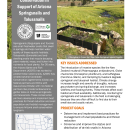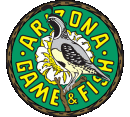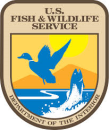Location













States
ArizonaIntroduction
Springsnails (genus Pyrgulopsis and Tryonia) are small, aquatic snails that live in springs and seeps (areas where water slowly seeps out of the ground, forming small ponds). Talussnails (genus Sonorella) are terrestrial snails that dwell in rock piles at the bases and the sides of mountains, called “talus.” Of Arizona’s over 200 native mollusks, there are 13 known Pyrgulopsis and three Tryonia species of springsnail, along with approximately 80 species of Sonorella talussnails. Springsnails control algae growth and other dead plant matter to help maintain high water quality, which supports other spring species. Talussnails feed on moss, lichens, and leaf litter in their environment, benefiting the environment by recycling nutrients and thereby enriching the soil of their habitat.
These Arizona snails are threatened by the effects of climate change climate change
Climate change includes both global warming driven by human-induced emissions of greenhouse gases and the resulting large-scale shifts in weather patterns. Though there have been previous periods of climatic change, since the mid-20th century humans have had an unprecedented impact on Earth's climate system and caused change on a global scale.
Learn more about climate change , including drought, wildfire, groundwater depletion and habitat disturbance (e.g. trampling by livestock, burros, and elk) in addition to threats posed by invasive species invasive species
An invasive species is any plant or animal that has spread or been introduced into a new area where they are, or could, cause harm to the environment, economy, or human, animal, or plant health. Their unwelcome presence can destroy ecosystems and cost millions of dollars.
Learn more about invasive species .
The Arizona Game and Fish Department (AZGFD) has identified 177 of Arizona’s snails as Species of Greatest Conservation Need under Arizona’s State Wildlife Action Plan. Many of these native snails are considered at-risk species under the U.S. Fish and Wildlife Service Region II At-Risk Species Program. Listing a plant or animal as federally protected under the Endangered Species Act (ESA) is proven to be successful in preventing extinction. However, this level of protection is America’s last line of conservation defense and has implications for resource managers. Ongoing and future collaborative conservation efforts for these at-risk snails in Arizona are necessary to maintain and improve their status and distribution that may preclude the need for listing.
For 30 years, AZGFD has partnered with private landowners, NGOs, county and federal agencies including the U.S. Fish and Wildlife Service, the U.S. Forest Service, the U.S. Bureau of Land Management, and the National Park Service to conserve and protect these at-risk snail species and their habitat. AZGFD uses Candidate Conservation Agreements (CCAs) to collaborate with federal land management agencies and some private landowners to better manage existing populations of Arizona snails. In addition, the Page springsnail (Pyrgulopsis morrisoni) has a Candidate Conservation Agreements with Assurances (CCAA) that covers Page springsnail populations in AZGFD hatcheries. CCAs are formal, voluntary commitments with federal agencies that address the conservation needs of candidate species, or species that are projected to become candidates in the near future. CCAAs are similar to CCAs but are typically made with non-federal partners. Partners of a CCA or CCAA implement agreed-upon conservation actions that minimize or eliminate threats to a species and help maintain and manage the habitat for those snails. With support of CCA or CCAA partners and community volunteers, AZGFD collects survey data to better understand the status of Arizona snails, then develops and implements best practices for snail population management, threat reduction, and habitat management to ensure Arizona snail conservation long-term.
Key Issues Addressed
Arizona springsnails are vulnerable to several human- and climate change-related threats because of their limited distribution and sensitivity to environmental changes. Climate change-induced drought, reductions in groundwater levels, and increases in wildfire severity and flooding have altered the natural environment of the snails in which they spent centuries adapting.
Talussnails risk desiccation from increasing and intensifying droughts. With less moisture, talussnails must seal to rocks for longer periods of time in between rainy weather, limiting their foraging and mating opportunities. Additionally, as invasive buffelgrass (Cenchrus ciliaris) becomes more prevalent across their habitat and droughts increase, it increases the fuel load for brush fires and increased erosion of soils around snail habitat.
Introduced animals and plants into snail habitat have added to the threats facing Arizona snails. For instance, the New Zealand mudsnail (Potamopyrgus antipodarum) outcompetes Arizona springsnails for food and habitat. Livestock trampling of springs and seeps affects springsnails by increasing silt and mud substrates and degrading water quality. Stinknet (Oncosiphon pilulifer), crowds out native grasses and groundcover plants and increases the fire hazards for talussnail habitat.
Talussnails and springsnails are small micro snails and are often difficult to find in the field without proper training and experience. Therefore, significant time and resources are required to effectively monitor, analyze data, and devise conservation and restoration plans for these native snails. To better understand Arizona snail distribution, genetics, life history, and threats, AZGFD requires additional survey and monitoring capacity.
Project Goals
- Gain a better understanding of Arizona snail distribution, genetics, life history, and threats to determine best practices for management of populations and threat reduction
- Conserve and improve the status and distribution of at-risk snails in Arizona through species population monitoring, habitat protection and improvement, translocation efforts, and preventing or reducing invasive species in springsnail and talussnail habitat
- Work with Candidate Conservation Agreement (with Assurances) partners to reduce threats to native snails and their habitats by identifying and implementing best management practices for native snails and their habitats
- Increase public awareness and support of Arizona snails through the use of apps such as iNaturalist and volunteer opportunities for citizen science
Project Highlights
Lions and Tigers and Snails, Oh My!: The Phoenix Zoo was the first to maintain and successfully propagate captive Pyrgulopsis springsnails, providing new information about the lifespan and breeding of captive springsnails.
- Monitoring: AZGFD conducts survey and monitoring efforts involving visual, timed counts of snails within their habitat. This gives AZGFD an estimate of relative abundance of snail populations year to year, or even seasonally. AZGFD also evaluates and documents habitat conditions and observed stressors as well as conducts environmental DNA sampling to help refine searches for native and invasive snails.
- Habitat Modification: AZGFD has implemented habitat protection and modification projects such as: installing fencing around springsnail habitat to prevent livestock trampling, modifying spring boxes (enclosures around spring heads to collect and divert water) to keep out invasive species such as crayfish, creating bullpen panel enclosures around snail-occupied springs to prevent elk wallowing, and replacing an old wooden shack over an extirpated springsnail site with a wire-mesh structure structure
Something temporarily or permanently constructed, built, or placed; and constructed of natural or manufactured parts including, but not limited to, a building, shed, cabin, porch, bridge, walkway, stair steps, sign, landing, platform, dock, rack, fence, telecommunication device, antennae, fish cleaning table, satellite dish/mount, or well head.
Learn more about structure that allows in more sunlight. Additionally, springsnail translocation efforts for Huachuca springsnails (Pyrgulopsis thompsoni) and endangered Three Forks springsnails (Pyrgulopsis trivialis) are underway to repatriate formally-occupied springs and new suitable habitat within historic range of those species. - Candidate Conservation Agreements: There are several active conservation agreements for Arizona snails including: the San Xavier talussnail (Sonorella eremita), the Pinaleno talussnail (Sonorella grahamensis) and six other native land snails of the Pinaleno Mountains, the Page springsnail (Pyrgulopsis morrisoni), and the Huachuca springsnail (Pyrgulopsis thompsoni) with several federal agencies and private landowners in Arizona. These Candidate Conservation Agreements (CCAs) and Candidate Conservation Agreements with Assurances (CCAAs) identify practical conservation and restoration measures such as maintaining sufficient groundwater and habitat for snail-occupied springs, periodic aquatic invasive species detection surveys with volunteers and CCA/CCAA partners, as well as annual monitoring of the snail populations and their habitat condition. AZGFD also has two new conservation plans in review for the Quitobaquito tyronia (Tryonia quitobaquitae) and seven other species of central Arizona springsnails.
- Public Outreach: The public’s usage of the Land Snails of Arizona project on iNaturalist provides AZGFD new records of native snails’ locations to target for further study. Furthermore, AZGFD trains volunteers how to monitor snail populations, providing invaluable support through collecting data, raising public awareness of the problems the snails are facing, and allowing AZGFD to maintain a current database of snail distribution.
Lessons Learned
Collaboration with smaller working groups on CCA-outlined conservation efforts like monitoring, research, and habitat modification leads to increased project knowledge among partners, more collaboration due to less turnover of partner staff over time, and reduced data management issues. Additionally, this leads to more credible and reliable volunteer data that eliminates the need to constantly retrain individuals, helping AZGFD focus on more pressing aspects of Arizona snail conservation. The same concepts apply to CCA groups, as smaller groups have an easier time communicating with one another, and can come to decisions quicker than large groups can.
Long-term CCA commitment among partners, about 10 to 25 years, is ideal for the success of conservation agreements and plans. A key component of the CCAs is that they are voluntary agreements. This helps encourage long-term commitment by inviting individuals and organizations into the agreements that are already interested in and aligned with conserving Arizona’s snail species, and the work that AZGFD is doing. Over the course of these long-term agreements, annual progress reports and working group meeting minutes provide good documentation of the conservation work being implemented and the status of the target species and habitat, as well as help track progress toward specific conservation goals. This documentation allows for adaptive management as results and new methods are applied, and helps maintain forward momentum over the 10-25 year timeframe.
A lack of immediate results does not mean a lack of success. For example, in 2017 immediately after the Goodwin Fire in Arizona’s Bradshaw Mountains, scientists could not locate one of the four Pyrgulopsis springsnail populations within the burned area. However, after five years of monitoring, AZGFD and conservation partners detected them again; the snails had survived the post-fire flooding. In another example, AZGFD and its partners completed a translocation of a small population of endangered Three Forks springsnails (Pyrgulopsis trivialis) in 2021 to an unoccupied spring within historic habitat for the snail. A year after that translocation, they did not locate any of those snails at that new site. However, in 2023, scientists found 40 of the Three Forks springsnails at the translocation site. This was the first successful wild-to-wild translocation of springsnails in Arizona.
Next Steps
- Create new and update existing conservation agreements and plans for additional springsnail and talussnail species including: five species of springsnails on Bureau of Land Management lands in Arizona, the Huachuca woodland snail (Ashmunella levettei) and other land snails of the Huachuca Mountains, the Phoenix talussnail in the Phoenix metro area and vicinity, and the Sonoran talussnail and other land snails in the Tucson area to Nogales in southern Arizona
- Document and disseminate information about the efficacy of snail translocation and captive rearing efforts and techniques
- Further genetic and taxonomic research on three new species of Pyrgulopsis in Arizona as well as genetic studies of talussnails, mountain snails, and woodland snails to support future conservation planning efforts
- Create a comprehensive inventory of micro-snails in Arizona
- Research the effects of fire-retardant exposure and its residue on snails in Arizona
Funding Partners
U.S. Fish and Wildlife Service, State Wildlife Grants to Arizona Game and Fish Department (past and present)
Resources
- Arizona Game and Fish Department. (2022). Arizona Wildlife Conservation Strategy: 2022-2032. Arizona Game and Fish Department, Phoenix, Arizona.
- Lavretsky P, Duenez E, Sorensen J. (2021). Population genetics and conservation of recently discovered springsnails in Arizona. J Molluscan Stud. 2021 Jul 13;87(3):eyab020. doi: 10.1093/mollus/eyab020. PMID: 34276251; PMCID: PMC8275448.
- Flesch A. D. and H.-W. Herrmann. (2021). Status, distribution, habitat, and stressors of the Sonoran Talussnail. Final Report to Arizona Game and Fish Department for Heritage Fund Grant Program, Project No. I18001. School of Natural Resources and the Environment, University of Arizona, Tucson, Arizona.
- Arizona Game & Fish Department (2024). State Wildlife Action Plan status definitions.
- Martinez, M.A., Sorensen, J. (2007). Effects of Sampling Without Replacement on Isolated Populations of Endemic Aquatic Invertebrates in Central Arizona.
- Wells, S., D. Pearson, T. Sprankle, J. Sorensen, & M. Martinez. (2012). Ex Situ Husbandry and Environmental Parameters Resulting in Reproduction of the Page Springsnail, Pyrgulopsis Morrisoni: Implications for Conservation.
- Maravi, J., W. Heuring, J. Sorensen. (2023). Successful propagation of imperiled springsnails at the Phoenix Zoo.
- Department of Defense, Fort Huachuca, U.S. Army Garrison
- Phoenix Zoo - Arizona Center for Nature Conservation
Contact
Jeff Sorensen, Invertebrate Wildlife Program Manager, AZGFD: jsorensen@azgfd.gov
CART Lead Author
Frances Clever, Case Study Writer, Indiana University
Suggested Citation
Clever, F. and Sorensen, J. A. (2024). “Conservation in Support of Arizona Springsnails and Talussnails.” CART. Retrieved from https://www.fws.gov/project/conservation-support-arizona-springsnails-and-talussnails.












